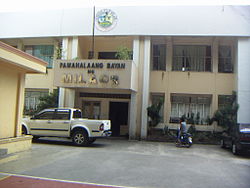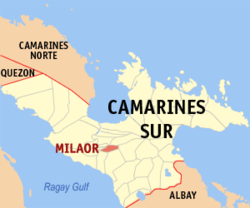Milaor, Camarines Sur
| Milaor | ||
|---|---|---|
| Municipality | ||

Municipal Hall
|
||
|
||
 Map of Camarines Sur showing the location of Milaor |
||
| Location within the Philippines | ||
| Coordinates: 13°36′N 123°11′E / 13.6°N 123.18°ECoordinates: 13°36′N 123°11′E / 13.6°N 123.18°E | ||
| Country | Philippines | |
| Region | Bicol Region (Region V) | |
| Province | Camarines Sur | |
| District | 2nd district | |
| Founded | May 1, 1585 | |
| Barangays | 21 | |
| Government | ||
| • Mayor | Anthony Lhabas Reyes | |
| Area | ||
| • Total | 33.64 km2 (12.99 sq mi) | |
| Population (2015 census) | ||
| • Total | 31,150 | |
| • Density | 930/km2 (2,400/sq mi) | |
| Time zone | PST (UTC+8) | |
| Income class | 4th class; partially urban | |
Milaor is a fourth class municipality in the province of Camarines Sur, Philippines. According to the 2015 census, it has a population of 31,150 people.
Milaor is politically subdivided into 20 barangays. Just like most cities in the Philippines, Milaor has a barangay system which is the core Local Government of the Philippines. Each barangay is headed by a chairman and barangay councils who were elected into office by popular vote of the community registered voters every three years.
The work of evangelization in Milaor began in 1579 when the Franciscan missionaries came to the Philippines upon the order of Pope Sixtus V and King Philip II, and given specific assignment to work in Bicol Region. In 1585, Milaor was declared a parish under the titular patron, Saint Joseph. The first parish administrator was Fray Matias de Andrade, OFM., who arrived in Bikol in 1582 and later became the fifth Bishop of the Diocese of Nueva Caceres.
The Franciscans, Fray Juan del Sacramento and Fray Jose dela Virgen, initiated the construction of a church made of bricks and stones. This was built in a place known today as "Sinimbahanan" now a part of Cabusao, where ruins of the concrete foundation may still be found. Frequent attacks from the cimarrones and the tulisanes from nearby Mount Isarog, however, caused the transfer of the church to its present site. Fray Santiago de San Pedro de Alcantara completed the construction in 1730 and added a convent made of wooden materials in 1735. Both the church and the convent were destroyed by fire in 1740 and immediately the reconstruction was undertaken by Fray Francisco delos Santos, OFM. The present belfry was finished in 1840.
Milaor was formerly called "Milaud" or "may-laud". "Laud" means a lowland prone to being flooded, in fact that is being true up to this day. The expression "mapa-laud" means to go to a place which is low or with water, in other words, to go to a "laud". From "Milaud" or "Maylaud" it was transferred to "Milaor". The truth of this matter of the place being always filled with water is corroborated by the fact that in many barangays are to be found shells which thrive on water. These shell fossils mean that in ancient time this place was really covered with water or is frequently flooded to allow these shells or mollusks to thrive in the place.
Originally, Milaor comprised Palestina and the present parishes of Minalabac, San Fernando and Gainza. Until the eve following the uprising Naga City on September 19, 1898 during the Philippine Revolution, the Franciscan considered Milaor as their favorite resting place and abode away from the adjacent rapidly developing settlement that is Naga City today.
...
Wikipedia


